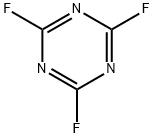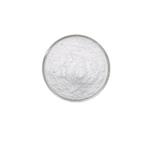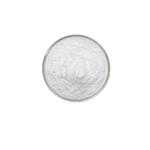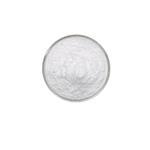Synthesis
HF offers the attraction of cheapness, although this may be offset by its handling
difficulties and lack of reactivity due to H-bonding. However, it may be used to
fluorinate very reactive substrates. Trichlorotriazine may be converted to
trifluorotriazine.

Chemical Properties
Colorless liquid. Decompose violently with water and alcohol.
Characteristics
Cyanuric fluoride is a key intermediate in the synthesis of fluorine homotriazine reactive dyes. Compared with the traditional chlorotriazine reactive dyestuff, fluorine homotriazine reactive dyestuff has the following five advantages:
1. Energy saving, low dyeing temperature (medium temperature type) 60℃, lower than KE type reactive dyestuff and comparable to M type reactive dyestuff.
2. Emission reduction, environmental protection, high fixation rate, 15-20 percentage points higher than the corresponding chlorotriazine reactive dyestuff fixation rate, can improve the utilization rate of dyestuff, but also reduce the environmental pollution in the printing and dyeing process.
3. Good stability of dyestuff.
4. High stability of peroxide resistance.
5. Not restricted by AOX regulations.
Uses
Cyanuric fluoride acts as a fluorinating agent used in the conversion of carboxylic acids into acyl fluorides. It is used as a precursor for fibre-reactive dyes. It is a specific reagent for tyrosine residues in enzyme. Further, it is involved in the preparation of cyanuric acid by hydrolysis
Preparation
In a dry three-necked flask equipped with stirrer, thermometer and reflux condenser, add 0.2mol (36.9g) of cyanuric chloride, 0.63mol (36.5g) of finely ground anhydrous potassium fluoride, 60mL of xylene and 2.0g of polyethylene glycol-600, heat and stir at 110℃, reflux for 16h and distill after a little cooling, collect the fraction at 72℃~75℃, and get liquid of cyanuric trioxide.
General Description
Liquid.
Reactivity Profile
Cyanuric fluoride is used as a mild fluorinating agent for organic chemicals, and it reacts with water in a manner similar to an acyl halide, forming hydrofluoric acid and cyanuric acid. Since it forms hydrofluoric acid, cyanuric fluoride is a source of soluble fluoride ions. Unlike other halide ions, fluoride is quite reactive, acting as a weak base and participating in some unique reactions. In particular, fluorides react strongly with compounds containing calcium, magnesium, or silicon ions, which means that solutions containing soluble fluorides are corrosive to both living tissue and glass. Hydrofluoric acid can cause severe chemical burns and is one of the few materials that can etch glass. It is also a toxic gas in its anhydrous form.
Health Hazard
Cyanuric fluoride is highly toxic by skin contact and inhalation.
Fire Hazard
When heated to decomposition, Cyanuric fluoride emits very toxic fumes of fluorides and nitrogen oxides. Avoid decomposing heat.






